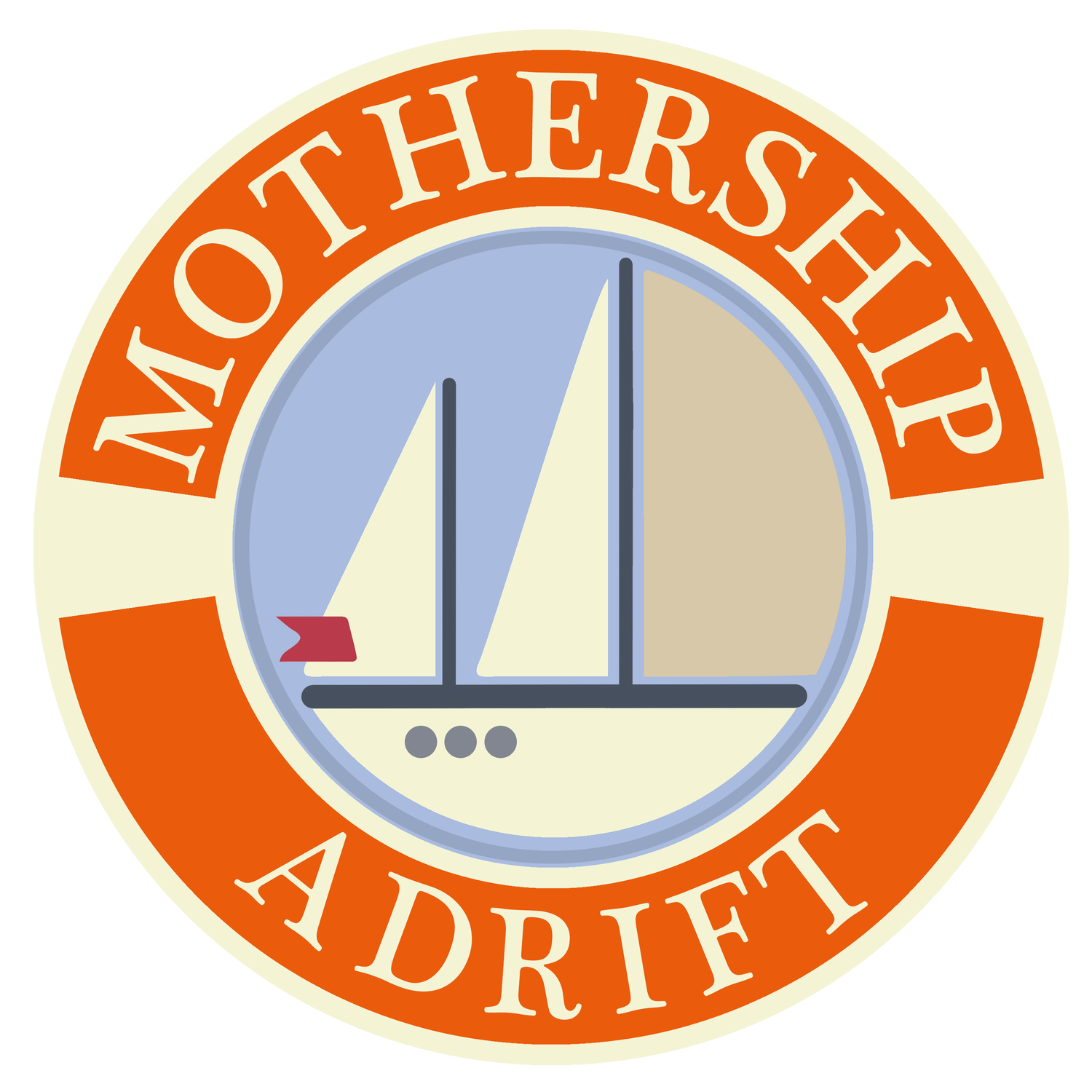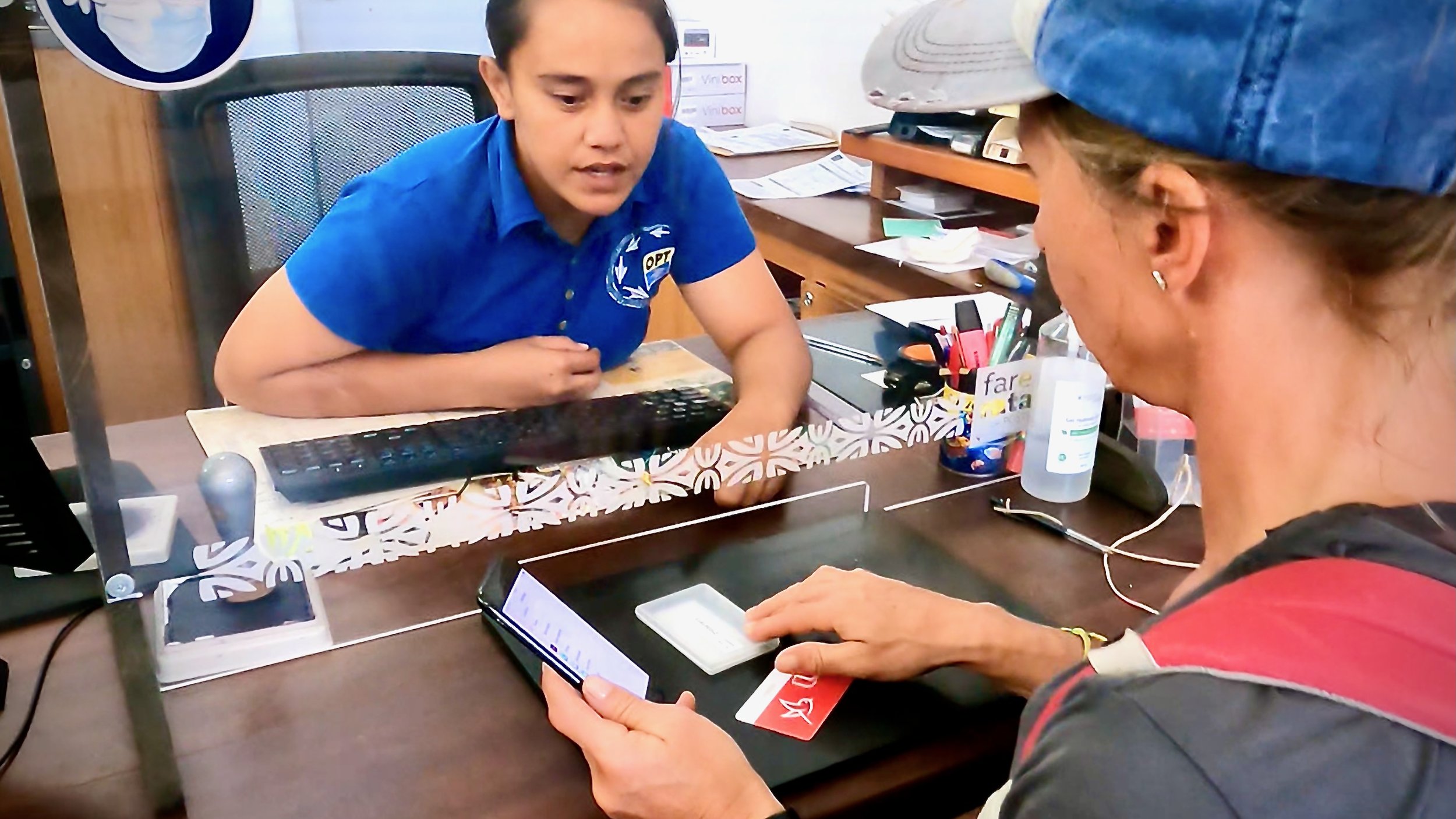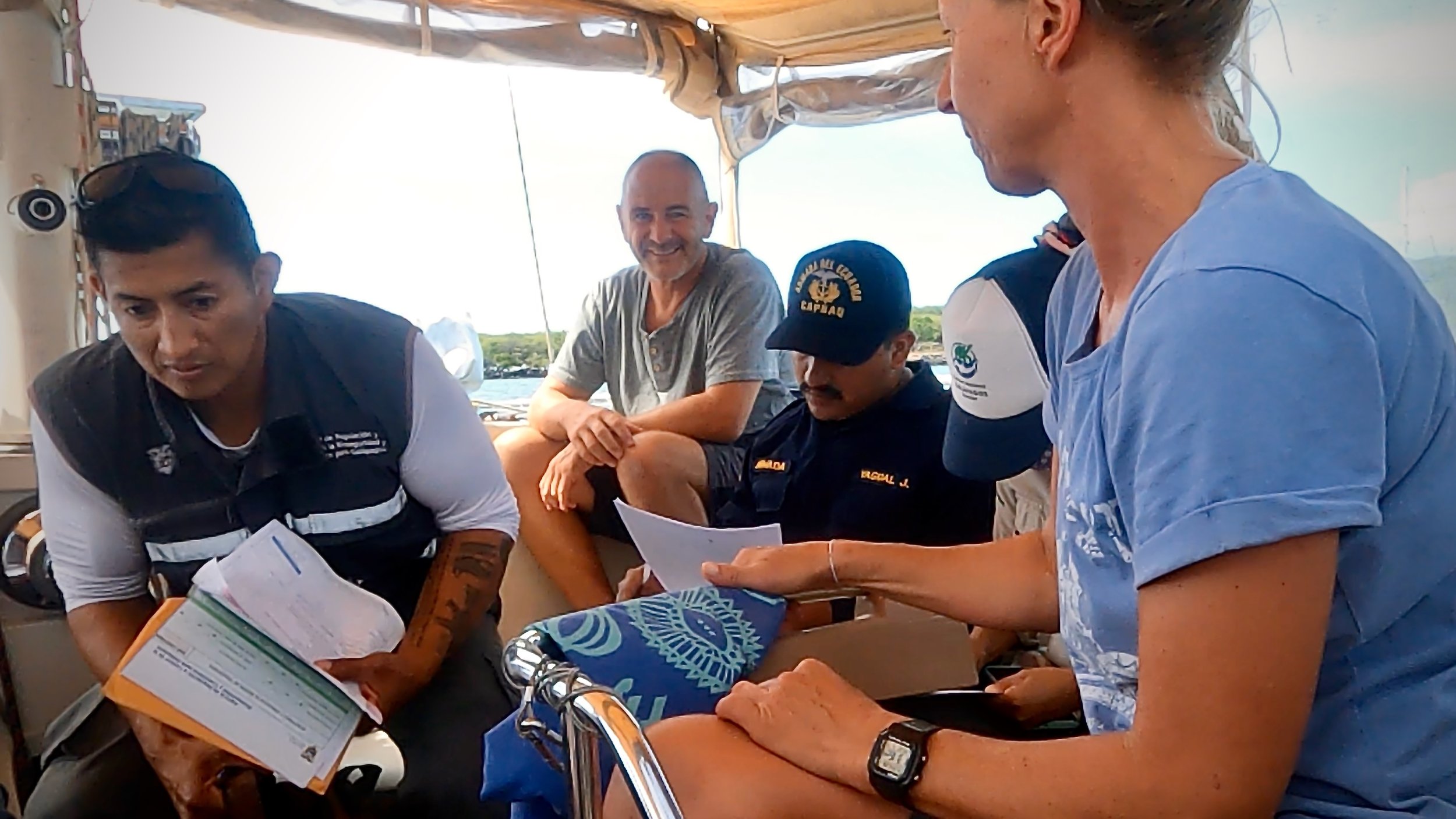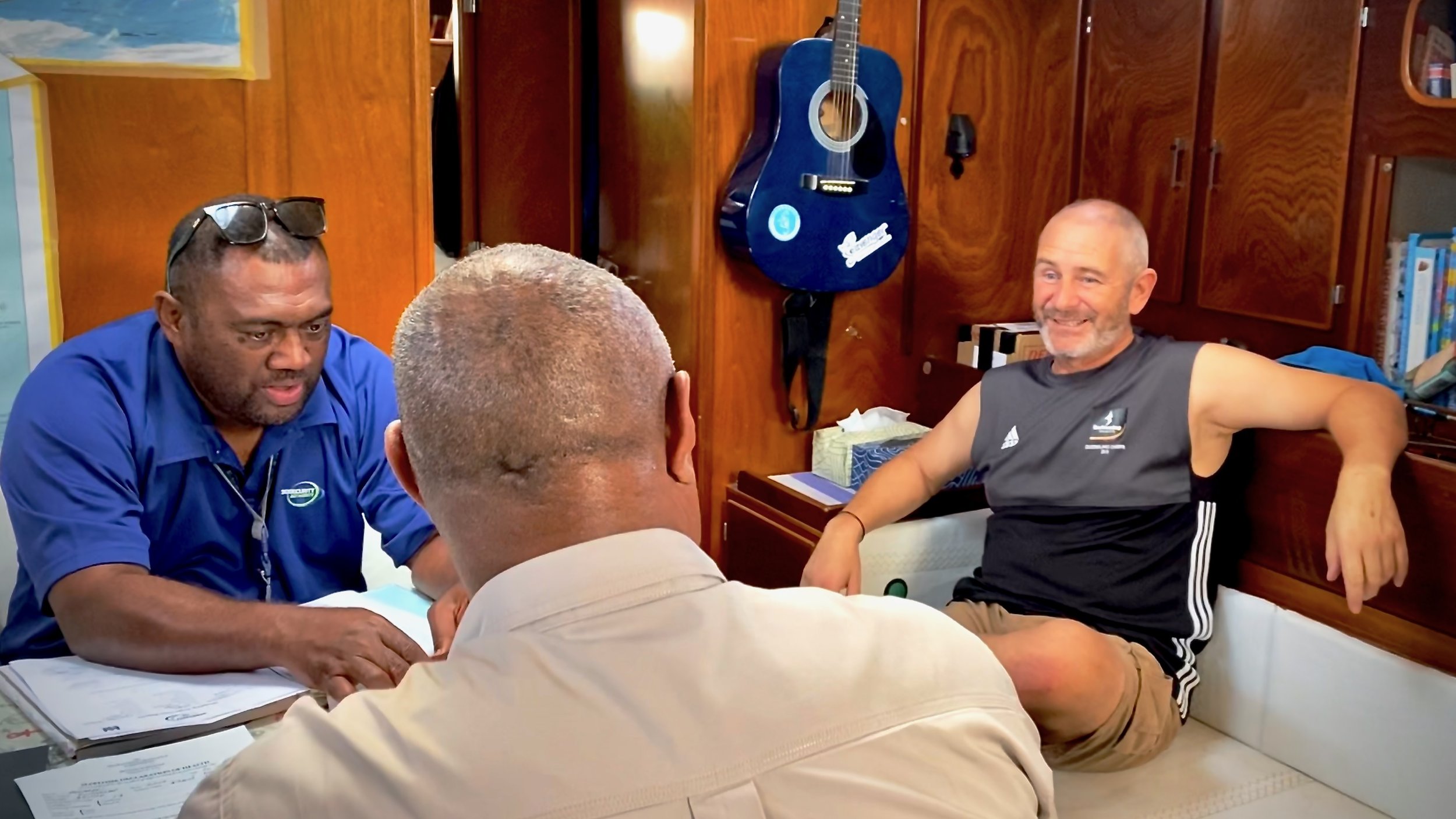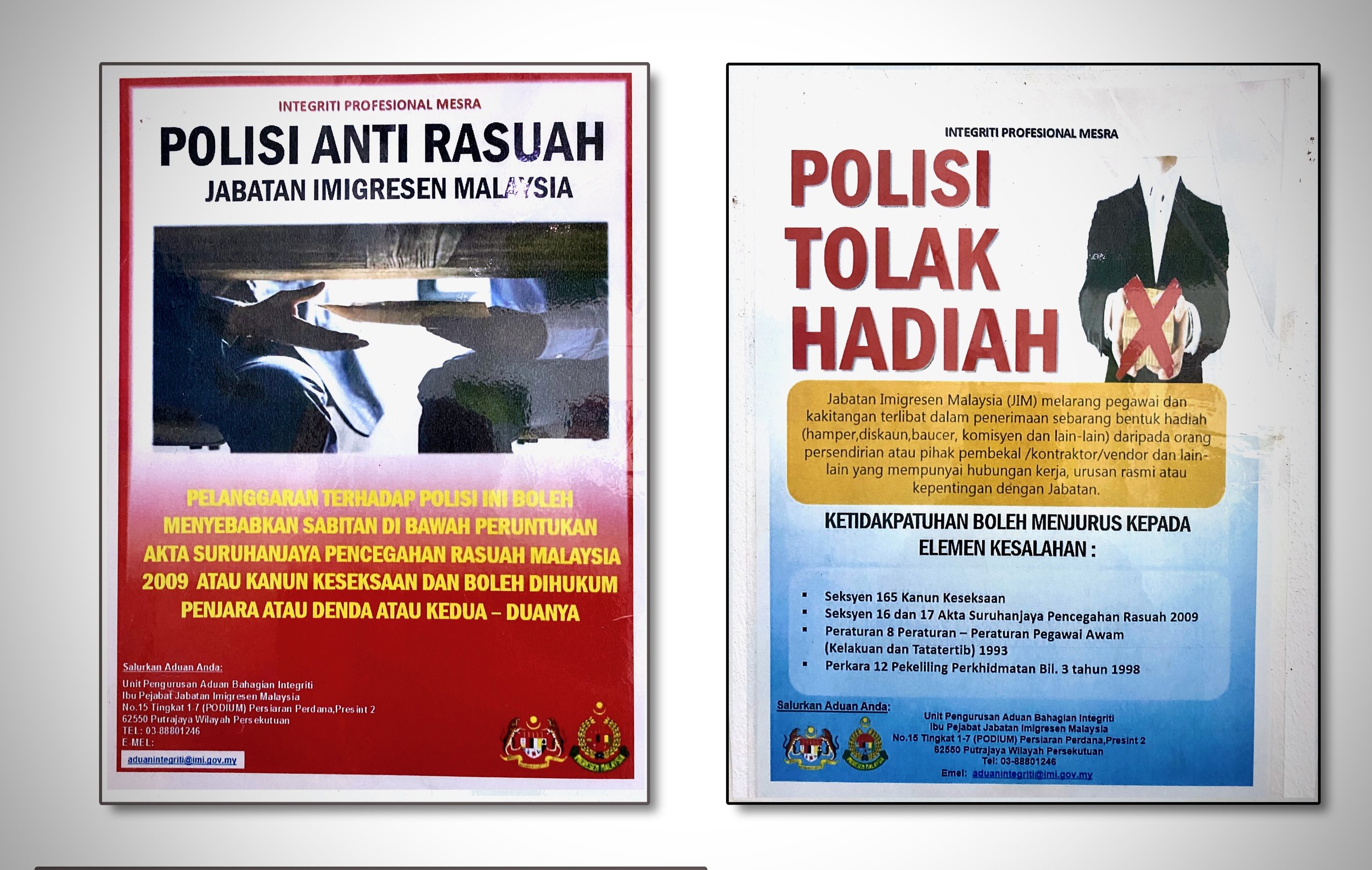Clearing-In to Foreign Countries Pt:03 - Dealing with Officials and Agencies
01-04-03
“Bureaucracy is the art of making the possible impossible.
”
Buying a sim card in French Polynesia in order to get online to buy mandatory (fake) plane ticket to download and show to immigration.. that we would never need. - Huku Hiva, French Polynesia
LAND AHOY! Now What?
So, you’ve sailed an ocean, and land is finally in sight. You’re tired and disheveled, but now is not the time to relax and crack open a cold one as tempting as that is; you’ve still got hoops to jump through. Bureaucratic hoops.
Start by hoisting the courtesy flag and a yellow ‘Q’ flag on the starboard flag halyard. This signals to officials that you require clearance. Next, contact the Harbour Master, Port Authority, or marina via the designated VHF channel or phone number to request instructions on how to proceed. This is where the eSIM mentioned in the previous post can come in handy. If you don’t receive a response, you may need to proceed without instruction, in which case your Pilot Guide for the Port of Entry, also mentioned previously, becomes invaluable.
You may be required to anchor in a designated location or tie up at a quarantine pontoon and wait for officials to arrive. Sometimes, you might need to pick them up in your dinghy and bring them to your boat. Yes, you (after crossing the ocean) may now find yourself as the unpaid dinghy Uber for clipboard-wielding agents. In other cases, you may have to travel into town or across an island to locate them yourself. Another instance where your eSIM proves useful, whether navigating with Google Maps or the NoForeignland app.
Despite an ocean crossing, you might need to pick up agents and become an unpaid dinghy Uber for the afternoon! Fiji.
If you’re clearing in without an agent and need to visit separate authorities yourself, pay close attention to the order in which you do so. Some officials may require a stamp or documentation from another authority before proceeding with their paperwork. Additionally, you may be asked to present the same documents multiple times or provide copies to different agencies, so keep everything accessible until the entire process is complete.
Pay close attention to the order at which each agency is supposed to clear you in and out - it's not always the same. - Malaysia.
As emphasised in the previous post, dressing smartly can be crucial in certain cultures. Personal grooming matters, too. Reserve some water for a shower and tidy up before meeting officials. If they’re coming aboard, ensure your boat is clean and organise your trash into durable bags, especially if biosecurity or health authorities are involved.
Offering snacks can earn you goodwill and smiles in places like Fiji, but in stricter countries like New Zealand, it might prompt a more thorough inspection of your bilges for restricted foods. Stick to offering cold bottled water and the most boring biscuits you can find if you’re unsure. This will also ensure they don’t stay for longer than necessary!
When checking into Fiji we made the mistake of offering cakes and tea and spent the next few hours discussing judaism in eastern Europe with a jolly official who for some unfathomable reason presumed Irenka was Jewish.
Agencies, paperwork, and procedures may vary, but they are broadly similar. In some cases, Health and Biosecurity may be combined into a single agency. Nevertheless, if you’ve followed the advice from previous posts on the clearing-in process, you should have all the necessary information at hand.
Health and Biosecurity may be separate agencies or in some cases, combined into a single authority. - Galapagos Islands.
Finally, a word of caution: there are no universal rules for clearing in. Agencies, procedures, and paperwork can differ wildly. One country’s customs officer might be fixated on your cat’s vaccination records, while another might barely bat an eye at a stash of rum large enough to supply a small navy. Treat all advice and information here as guidelines, not gospel.
But fear not! If you’ve followed my earlier advice, you’ll soon be enjoying that well-deserved drink on deck—provided it hasn’t been confiscated, like my Frey Bentos Steak Pie, which I’d saved as a celebratory treat upon arriving in New Zealand.
You owe me, New Zealand!
Coast Guard/Customs and Border Protection (CBP):
Often Customs and the Coastguard come under the same authority. - Fiji.
CBP is responsible for regulating and facilitating international trade and travel. Their role includes enforcing customs laws, processing declarations, and collecting duties.
Paperwork/Procedures:
Boat Registration
Boat Bill of Sale
Boat Details
Crew List
Boat Insurance
Zarpe
Customs Declaration Form
Immigration Authorities:
Sometimes the offices can seem quite cavernous, while other times…
Sometimes agents come aboard, other times you have to traipse across town to find a window! - Malaysia and Suriname.
Immigration authorities manage the entry and stay of individuals in a country, ensuring compliance with visa requirements, conducting inspections, and maintaining immigration records.
Paperwork/Procedures:
Crew List
Passport
Visa
Boat Details
Zarpe
Harbour Master/Port Authority:
Sometimes it's hard to know who is who!
The Harbour Master or Port Authority oversees the safe and orderly movement of vessels within a port, manages berthing, enforces port regulations, and ensures compliance with local maritime laws. Call the harbour master or port authority on the phone or on the designated VHF channel as you approach to receive berthing instructions and comply with local regulations.
Paperwork/Procedures:
Boat Registration
Boat Insurance
Health Authorities:
Staying relaxed and friendly (despite sleep deprivation from an ocean crossing!) makes the process easier. - Fiji
Health authorities are responsible for safeguarding public health. Their role in clearing-in procedures involves assessing the health of individuals on board and preventing the spread of infectious diseases. Covid saw these authorities take a far more prominent role in the clearing-in process.
Paperwork/Procedures:
Health Certificates
Vaccination Records
Biosecurity Authorities:
Opening hours can be an issue especially around weekends and national holidays. Even if agencies are open on weekends you will usually have to pay more to clear in. - Fiji
Environmental protection agencies or agriculture/food inspection agencies (collectively known as biosecurity) focus on protecting the local ecosystem and preventing the introduction of invasive species, harmful organisms, or diseases to protect the environment, agriculture, and public health. They may inspect your hull for aquatic invasive species or food bilges for egg, pork, and poultry-based products and even wooden souvenirs that could contain wood-boring insects.
Paperwork/Procedures:
Declaration of Recent Ports
Hull Cleaning Record
Declaration of Food and Agricultural Products
Armed Forces / Police Authorities:
Take snacks, water and some form of entertainment. Don't expect comfort, working printers, photocopiers or wifi. - Tual, Indonesia
Although less common, in some countries police, military or naval authorities may be involved in the clearing-in process, especially in regions with heightened security concerns.
Paperwork/Procedures:
Specific procedures can vary widely from country to country so just make sure you have all documents with you when dealing with the armed forces and police while clearing-in.
The Good Paperwork!
Not all paperwork is taxing. Most developed countries have some form of tax exemption certificate, such as a ‘control permit’ or ‘GST form,’ for ‘yachts in transit’ that is issued to you by customs agencies at clear-in. You may have to request it as it won’t necessarily be voluntarily offered.
Once received, you can present this document to local retailers when purchasing goods and services. Some will ask for it in digital form (a scan or photograph will do) but once on their system, everything you buy will have tax deducted. Even retailers unfamiliar or unwilling to handle tax paperwork will sometimes offer a discount equivalent to the tax percentage of the price.
Using our ‘GST form,’ in New Zealand, we saved enough money to pay for a new 15hp outboard. Also purchased tax-free!
Bribery and ‘Gifts’
Most places are aware that bribery takes place and have signs to warn you against attempting it - so don't.
Being stubborn and British, I’d rather sit sweating belligerently in a dusty, hot office for half a day than bribe an official to expedite a job they’re already paid to do. And to be honest, from what I’ve witnessed, bribery never works out well, either for the person doing the bribing or, more importantly, for the people who come after them. Greed begets greed, and if cruisers gain a reputation as easy cash cows, word spreads, and the clearing-in process becomes even more confusing and convoluted for everyone.
That said, it’s important to recognise that in some cultures, small "gifts" are viewed as part of the process rather than outright corruption. However, cruisers should be cautious not to encourage exploitative practices by inadvertently expediting the value of these gifts.
Sometimes, unexpected "fees" are requested, and it’s never entirely clear whether you’re paying legitimate charges or merely stuffing a brown envelope. When only cash is accepted, and receipts are conspicuously unavailable, it doesn’t take a genius to figure out it’s probably the latter. In such cases, politely but firmly requesting clarification or merely a receipt can sometimes dissuade such dubious practices.
Occasionally, during an "inspection," an official might pick up a bottle of whiskey and thank you for your "gift." In such situations, the only realistic response is to smile politely and take it on the chin—then document the encounter and share your experience on platforms like social media or apps such as NoForeignLand, tagging local tourism and government authorities to help address the issue.
To avoid unwanted attention, ensure all valuables and expensive liquor are hidden well out of sight. And if you have young kids, don’t let them see where you’ve stashed anything. Because when it comes to the "inspection" and you’re adamantly denying owning anything other than a couple of beers and that bottle of Château de Vin de Merde on display, your little one might point to the bilge where you concealed that rare single malt and gleefully announce, "Yes, you do, Daddy! It’s in there!”, as happened to one of our buddy boats.
Finally, remember that paying a bribe, even under pressure, can have consequences. Some countries strictly enforce anti-corruption laws, and a single misstep could turn a minor inconvenience into a major legal headache.
You’ve made it!
If you want to get philosophical about it, think of the cruiser’s battle with the clearing-in process as a clash between freedom and confinement. Bureaucracies are run by those who prioritise obedience and procedure over individuality and efficiency, often viewing confinement and stagnation NOT as necessary evils as we do, but as the norm, rigidly defined by compliance with sometimes absurd systems. It’s that mindset that keeps them working a 9-to-5 government job while you’re out cruising the world.
So, be nice! Once you’ve completed the process, you can finally take down the yellow ‘Q’ flag, crack open that rare single malt (if it hasn't previously been 'gifted'), and start looking forward to doing it all over again when it’s time to clear out.
Cheers!
That concludes the three part epic on clearing in. Next week we turn to relationships and mental health challenges aboard.
If you want more straight-talking tales from life afloat, and information on clearing in a sailboat to foreign countries, then you’ll love our upcoming book. We're inviting early readers to join the pre-launch crew and get behind-the-scenes access as we wrestle it into shape. It’s honest, unfiltered, and occasionally useful. Sign up here to get involved, give feedback, and be part of something that’ll either be a bestseller or a brilliant cautionary tale.
